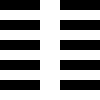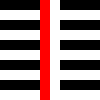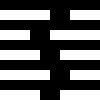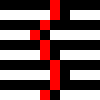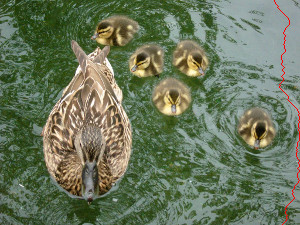PA4 - Seam Carving
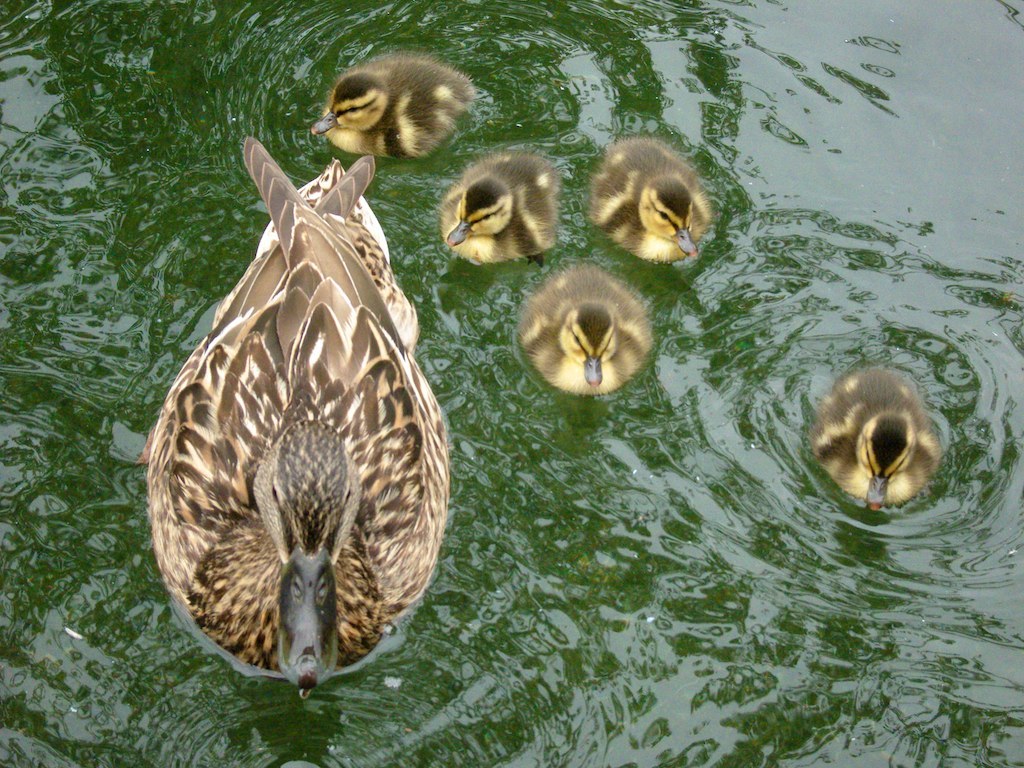
George Costanza needs our help! In the summer of 1989, after the “boombox incident” on the beach, he finds that he is in the background of his new boss’ family photo. The technology of the time, airbrushing, caused him some trouble, but now there’s Photoshop, Gimp, and more importantly, seam carving! Before we move on to George’s slightly more complicated version of the problem, let’s start with the ducks pictured above. We want to remove the “less interesting” parts of the picture (the water) to bring the ducklings closer to their mother. You must write a dynamic programming algorithm that finds the lowest-energy “seam” in the image.
You will be given a color picture consisting of an \(n \times m\) array image[0..n-1][0..m-1] of pixels as seen in the diagram below, where each pixel specifies a triple of red, green, and blue (RGB) intensities. The intensity of a color is an integer value between \(0\) and \(255\). Specifically, accessing the red intensity of pixel \(p_{i,j}\) (the pixel in image column \(i\) and row \(j\)) would be image[j][i][0], the green intensity would be accessed by image[j][i][1], and the blue intensity accessed by image[j][i][2]. Note: for images, the \((0,0)\) position is the top-left corner of the image.
Our images are stored in
image[j][i][c], where \(i\) is the \(x\)-coordinate of the image and \(j\) is the \(y\)-coordinate of the image. The \((0,0)\) coordinate is the top-left of the image. At each \((i,j)\) position, there is a triple (\(c \in \{0, 1, 2\}\)) of color intensities.image[j][i][0]is the red intensity,image[j][i][1]is the green intensity, andimage[j][i][2]is the blue intensity.
To move our ducks closer, we wish to remove one pixel from each of the \(n\) rows of the image, so that the whole picture becomes one pixel narrower. But we also want to avoid any disturbing visual effects, so we require that the pixels removed in two adjacent rows be in the same or adjacent columns; therefore the pixels removed form a “seam” from the top row to the bottom row where successive pixels in the seam are adjacent vertically or diagonally.
We also want to remove the less interesting parts of the picture, so we also want to calculate the real-valued energy measure \(e(p_{i,j})\) for each pixel in our image. We define this measure as the average of how different a pixel’s colors are from its eight neighboring pixels (i.e., the pixels immediately adjacent to the top, left, right, and below, as well as the four diagonally-adjacent ones). Specifically, the energy of pixel \(p_{i,j}\) is defined as
\[{ e(p_{i,j}) = \frac{1}{8} \sum_{x = i-1}^{i+1} \sum_{y = j-1}^{j+1}} d(p_{i, j}, p_{x, y}),\]where the difference in pixel colors is defined by their 3D Euclidian distance,
\[d(p_1, p_2) = \sqrt{(p_2[\mathrm{red}] - p_1[\mathrm{red}])^2 + (p_2[\mathrm{blue}] - p_1[\mathrm{blue}])^2 + (p_2[\mathrm{green}] - p_1[\mathrm{green}])^2}.\]Note that by definition, \(d(p_{i,j}, p_{i,j}) = 0\), so the energy function is indeed computing the average difference between a pixel’s colors and those of its eight neighbors. If a pixel is on the edge of the image, calculate the average of differences between its colors and those of its available neighbors. Intuitively, the lower a pixel’s energy measure, the more similar the pixel is to its neighbors. We define the energy measure of a seam to be the sum of the energy measures of its pixels. Your algorithm must find a seam with the lowest energy measure.
For this assignment, you are provided scaffolding code that reads in an image and converts it to a 3D array of pixel color information. It then passes that array to the SeamCarving class, which you will implement, to find the lowest-weight seam. Finally, it prints out the weight of the seam, the ordered \(x\)-coordinates of the seam, and has a commented-out section to highlight and graphically display the seam for testing purposes. You must implement the compute() method that accepts the 3D image array and returns the weight of the lowest-weight seam (as a double-precision number). Your method must also use backtracking to store the seam as an ordered list of \(x\)-coordinates (from top to bottom of the image) as an instance variable to be returned by the getSeam() getter method that you must also implement. That method should return an array of integers.
Runtime
Since we want to eventually use this algorithm to help out George, we want it to be efficient. Therefore, your algorithm must run in \(O(nm)\) time.
Examples
For each of the examples below, we’ll provide the original image, an example seam (there may be multiple!), and the output from our solution (again, you might find a different seam of the same weight!). For the small tests, we’ve scaled them up for visibility online, but we’ve provided the 10x10 images in the zip folder for this PA.
10x10 Test1
|
(a) Original Image |
(b) An example Seam |
weight: 839.1786162671211
seam: [4, 4, 4, 4, 4, 4, 4, 4, 4, 4]
time: 0.004
10x10 Test2
|
(a) Original Image |
(b) An example Seam |
weight: 894.3877357583791
seam: [5, 5, 4, 3, 4, 4, 5, 5, 5, 4]
time: 0.004
Ducks
|
(a) Original Image |
(b) An example Seam |
weight: 2084.8176202077766
seam: [274, 274, 275, 275, 276, 277, 278, 278, 278, 279, 280, 281, 281, 280,
279, 278, 278, 277, 278, 277, 276, 275, 275, 275, 275, 275, 276, 277, 278,
279, 280, 281, 282, 282, 283, 284, 285, 284, 284, 284, 285, 286, 285, 284,
283, 284, 284, 284, 285, 285, 285, 285, 284, 283, 282, 281, 281, 281, 280,
281, 281, 282, 281, 281, 282, 281, 282, 283, 282, 282, 283, 284, 285, 284,
284, 285, 284, 283, 283, 284, 283, 282, 281, 280, 279, 279, 278, 278, 279,
280, 281, 282, 283, 284, 285, 286, 287, 288, 289, 288, 288, 289, 290, 291,
292, 293, 294, 295, 296, 297, 297, 297, 298, 299, 299, 298, 299, 299, 299,
299, 299, 299, 299, 299, 299, 298, 298, 298, 299, 298, 299, 299, 299, 299,
299, 299, 299, 299, 299, 299, 299, 298, 297, 297, 297, 297, 297, 296, 297,
297, 296, 297, 296, 296, 295, 296, 296, 296, 297, 298, 299, 299, 299, 298,
299, 299, 299, 299, 298, 299, 298, 299, 299, 299, 298, 297, 297, 297, 297,
298, 299, 299, 298, 297, 296, 295, 294, 293, 294, 293, 292, 293, 294, 295,
296, 297, 296, 295, 294, 293, 292, 291, 290, 289, 288, 287, 286, 285, 284,
283, 283, 282, 281, 282, 283, 284, 285, 286, 286, 285, 286, 285, 284, 284,
283]
time: 0.012
Implementation
Your program should have the following properties:
- Your algorithm must be written in Python 3.10.6 or Java 19.0.2 (OpenJDK)
- You must download the appropriate wrapper code based on the language you choose:
Main.pyandSeamCarving.pyfor Python,Main.javaandSeamCarving.javafor Java.- Java package: pa4-java.zip
- Python package: pa4-python.zip
- Implement the
compute()andgetSeam()methods in theSeamCarvingclass. Thecompute()method should execute the entirety of your algorithm and store the seam and seam weight as instance variables;getSeam()should return the resulting seam without additional computation (i.e. it should be a “getter”). - Two test images are provided, along with the picture of the ducks above. You should produce additional tests, including edge cases.
- You may modify the
Mainfiles to test your algorithm, but they will not be used during grading. - You must submit your
SeamCarvingfile to Gradescope. Do not submitMain.java,Main.py, or any test files. - You may submit your code a maximum of 15 times to Gradescope. After the 15th submission, Gradescope will not run your code.
- A few other notes:
- Your code will be run as:
python3 Main.pyfor Python, orjavac *.java && java Mainfor Java. - You may upload multiple files if you need additional classes for Java, but do not assign packages to the files.
- You may use any editor or IDE you prefer as long as the code can be executed as stated above.
- We strongly encourage you to practice good development as you write code: use meaningful variable names, break your code into functions, “code a little then test a little”, use the debugger, etc.
- Your code will be run as:
Rules on Collaboration and Outside Sources
You may discuss the problem and the overall strategy with up to 4 other students, but you must list those people in your submission under collaborators. You may not share code, look at others’ code, or help others debug their code. You must write your own code. Not just type it (though you need to do that too): compose it yourself, as your own original work. Please read the syllabus carefully around coding. Do not seek published or online solutions for any assignments. If you use any published or online resources (which may not include solutions) when completing this assignment, be sure to cite them. Do not submit a solution that you are unable to explain orally to a member of the course staff.
Use of Generative AI
For PA4, you are not allowed to use generative AI tools to help you solve this problem.
